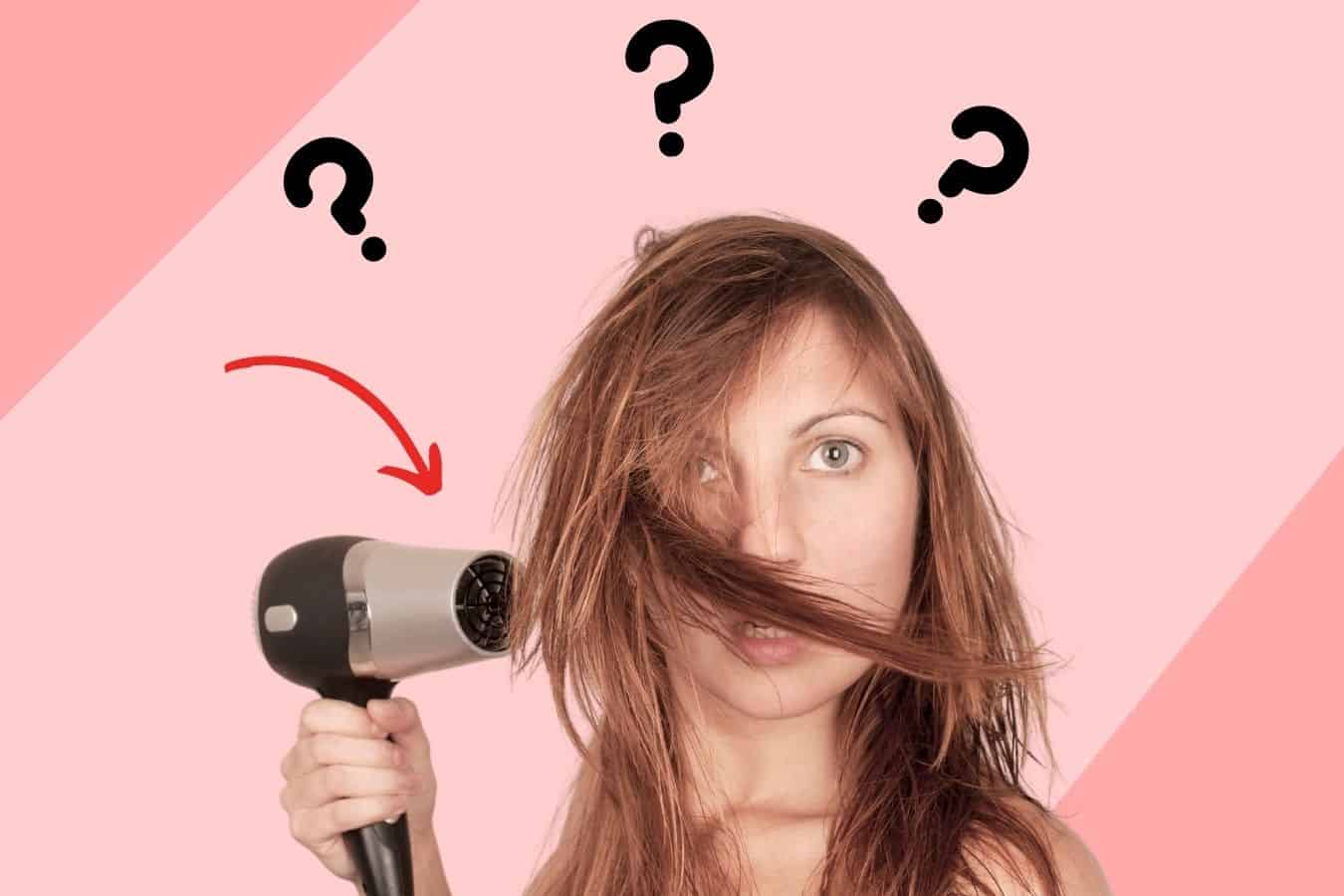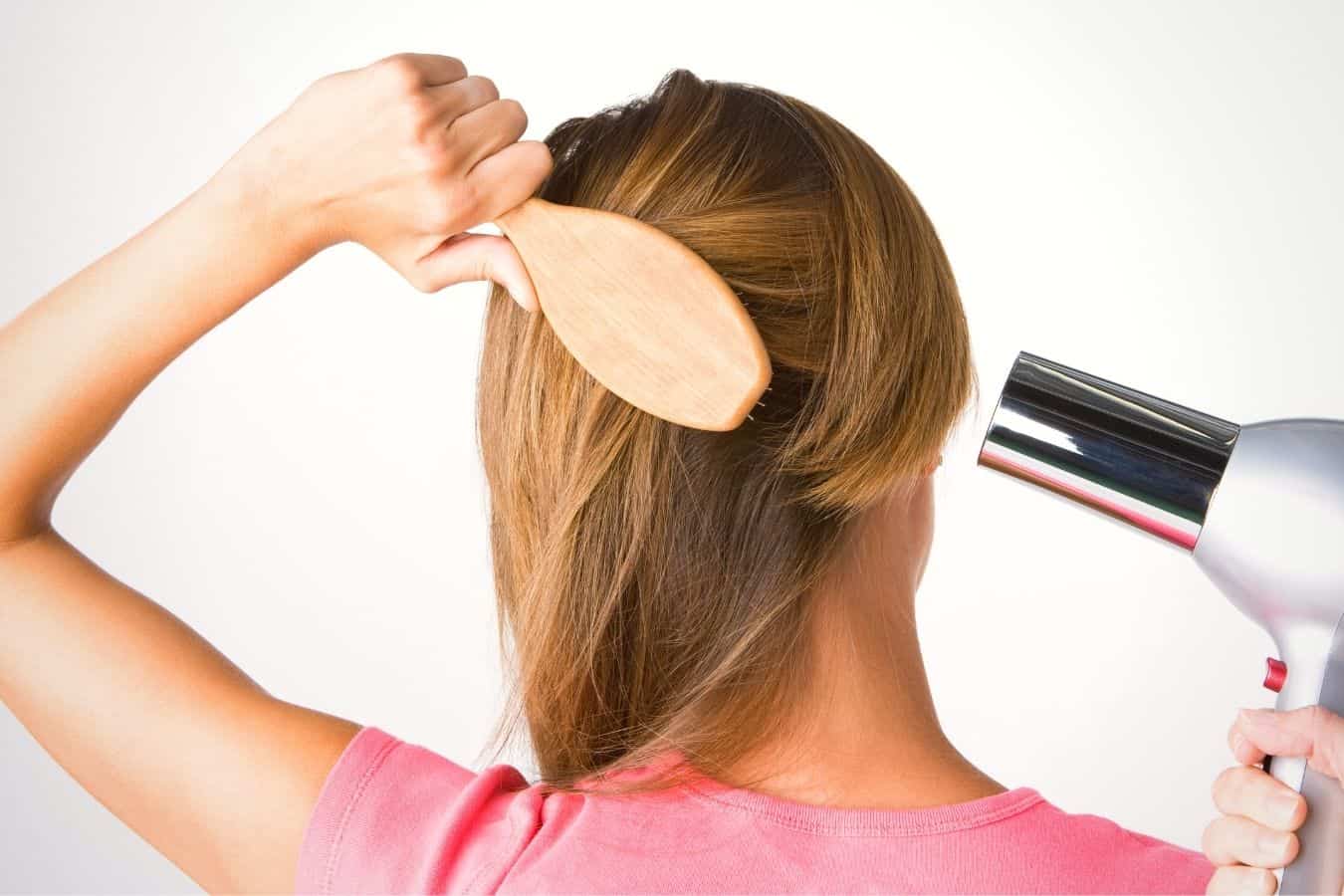Although it may seem hard to believe, there’s actually a right way and a wrong way to drying your hair. Do it the wrong way and you could end up causing more harm than good. In this article, we show you the steps that you can take to best dry your hair in a way that won’t damage it.

From avoiding using a towel to aggressively rub your hair dry, to drying your hair in sections with a hairdryer, these are the best ways to dry your hair in a way that will leave it healthy and happy.
Best Way to Dry Hair Quickly and Safely
Okay, here’s the thing: if you exclusively dry your hair with a hairdryer, the heat will frazzle your locks.
However, if you just air dry your hair, you might be encouraging breakage by using a towel that’s too rough, or tying your hair up when it’s still wet and fragile.
Below, we list the best ways to dry your hair. You can mix and match depending on what works for you and your routine.
In fact, it’s probably best to mix and match, because being overly reliant on one way to dry your hair might cause more harm than good.
- Use a towel to dab, blot, and gently squeeze out excess moisture. A microfiber towel is best.
- If you’re a curly girl, use the plopping method to dry hair safely without any heat.
- Blow dry your hair on a cool setting using a heat protectant. If you have a diffuser, you can use this to disperse the heat and encourage curls to form and set.
How To Towel Dry Hair Without Causing Damage
Remember, if you’re too rough with your towel, or if you tie your strands up when they’re still sopping, you’re only going to cause frizz, split ends, and breakage by pulling them from the root.
If you must use a regular towel, you want to be gently dabbing and blotting the water out of your tresses.
Squeeze gently to get out any excess, but don’t go wringing your locks or rubbing them aggressively. If you like a hair turban, be sure not to tie it too tightly, as this can also cause damage.
The best thing you can do to air dry hair is to grab a microfiber towel or turban.
These will gently dry your hair by wicking the water away thanks to the densely packed fibers. You can also treat your tresses to hair oil, moisturizing mask, or leave-in conditioner before you wrap them up.
As importantly, repeat after us: ‘I will never tie up wet hair.’
When your hair is wet, its cuticles are more vulnerable to damage because they’re swollen and stretched.
You should also avoid brushing it when it’s wet for the same reason. Get your brushing and detangling in before you shampoo.
If you have curly hair, you can also follow a method called ‘plopping’. This is another of the best ways to dry your hair without causing damage, and all it requires is an old t-shirt.
Always remember:
- Don’t brush your hair when wet, as this will cause damage due to splitting and stretching. Use a wide-toothed comb to detangle and brush your locks before jumping into the shower.
- Never use a towel to rub your hair in any way that will cause real friction. Gently pat or blot hair and use a microfiber towel.
- Don’t go out into cold weather with wet hair – it will freeze and break!
Also Read: Steam Straighteners Vs Hair Straighteners: Which Is Best?
How to Blow-Dry Hair Without Causing Damage

Blow-drying your hair is one of the best ways to dry your hair, but you do need to use a heat protectant in order to ensure your tresses aren’t exposed to the damage of heat.
Excess heat is your hair’s worst enemy. It’ll make your strands frizzy, dry, and unworkable.
Use the coolest setting on your hairdryer, and never blow it directly at your scalp or on one spot of hair for too long, as this will cause damage, removing the surface moisture of both your skin and hair.
Aim to keep the hairdryer at least six inches from your head, use a diffuser if you have it, and remember your heat protectant!
If you have the time, gently blot excess water from your hair with a towel before blow-drying. You also want to dry your hair in sections, not roast it in a blast of high heat.
Follow this method for blow drying your hair
- Use a towel to gently squeeze out excess water.
- Grab your styling product of choice, and work it into your locks from the roots to ends.
- Get hold of your heat protectant and use as directed.
- Next, you’re sectioning your hair. Divide your hair and use clips in order to keep sections out of the way as you dry different areas.
- Remember to use the cool setting!
- Start at your neckline and work from there. Concentrate the airflow down the hair shaft, and never leave it on one section for too long, as this may cause heat damage and burns.
- Once your hair is near-dry, you can turn the heat up in order to set your style and manipulate your hair.
- If you blast your look with cold air when you’re done, you’ll be resealing your hair bonds.
If you’ve got a diffuser, this is also a great way of both promoting curls and drying hair in a heat-averse way.
The diffuser disperses the heat so it’s not concentrated on one area, thereby minimizing frizz.
It’s also designed to encourage curls and waves to form and hold. It’s great if you’re in a hurry, making your tresses appear bigger, bouncier, and fuller.
Always remember:
- Never blow dry hair without a heat protectant. Using one is an essential step in protecting your hair from the damage that heat can cause.
- Sectioning your hair will make the drying process significantly easier.
- Always use the cool setting of your dryer. Once your hair is more dry than wet, you can turn the heat up slightly.
- Never concentrate the dryer on one portion of your hair or scalp, as this may cause burns.
How to Air-Dry Your Hair
If you’re a curly girl, one of the best ways to air dry your hair is called ‘plopping’.
All it needs is an old t-shirt or headscarf.
You’re avoiding heat damage and allowing the water in your hair to be absorbed, but not in any way that causes friction.
If you are in a rush to sleep but have just washed your hair (it happens, we get it) then there are steps you can take to protect your hair as much as possible.
Obviously use a towel to gently dry it as much as possible, but if your hair is still damp, you can massage a leave-in conditioner or hydrating mask to your strands. This will help to minimize damage.
If you can wrap your hair in a satin scarf or bonnet before you sleep this will also help to lock in moisture and minimize friction between wet hair and your pillow.
What Should You Avoid When Drying Your Hair?
- Avoid using a standard towel to rub your tresses, as this will cause breakage, and you may end up pulling some hair out if you’re too aggressive. One of the best ways to dry your hair is to use a microfiber towel or turban. Plus, if you’re a curly girl, you can use the plopping method.
- Do not sleep on, or tie up, wet hair. Just don’t. It will make your strands dry, tangled, and frazzled. Top tip – ensure your hair bobbles don’t have metal tags either, as these will only further snag wet hair.
- Don’t run your fingers through your hair! This is another habit that will likely cause tangles and frizz, as the oils on your fingers react badly with your strands and any styling product on them.
- Remember, if you let your hair dry too much, it won’t be manipulable. You need to be adding styling product to your tresses when they’re damp in order to add volume, bounce, and texture.
- Avoid blow-drying your hair at a high heat. It will fry your strands and scalp, and will cause frizz and dryness. The coolest setting is best.
- Remember to section your hair when blow drying it, and if you have a diffuser, use it.
Disclaimer: This site is not intended to provide professional or medical advice. All of the content on LovedByCurls.com is for informational purposes only. All advice should be followed at your own discretion. Ingredients may change at any time so always check the product label before using. Check our full disclaimer policy here.
